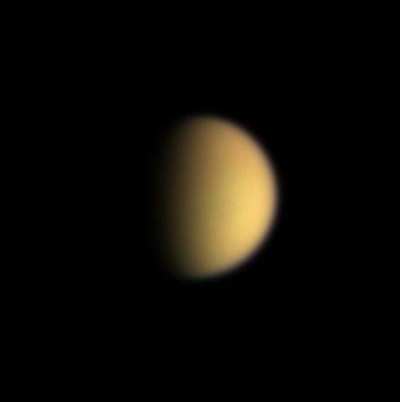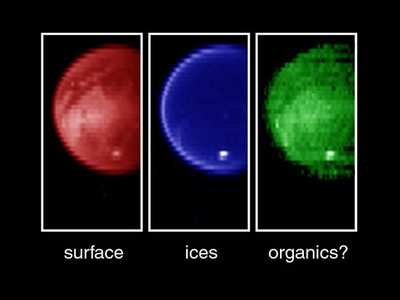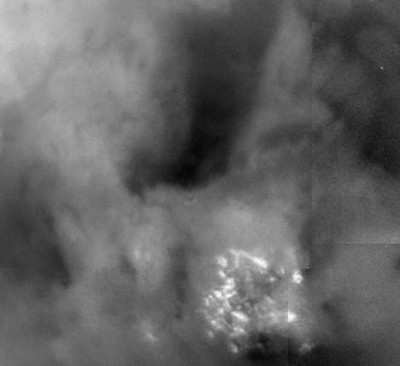Cassini Provides New Views of Saturn's Largest Moon
The Cassini spacecraft has revealed surface details of Saturn's
moon Titan and imaged a huge cloud of gas surrounding the
planet-sized moon.

Cassini gathered data before and during a distant flyby of the
orange moon yesterday. Titan's dense atmosphere is opaque at most
wavelengths, but the spacecraft captured some surface details,
including a possible crater, through wavelengths in which the
atmosphere is clear.
"Although the initial images appear bland and hard to interpret,
we're happy to report that, with a combination of instruments, we
have indeed seen Titan's surface with unprecedented clarity. We
also look forward to future, much closer flybys and use of radar
for much greater levels of surface detail," said Dr. Dennis Matson
of NASA's Jet Propulsion Laboratory, Pasadena (CA), project
scientist for the international Cassini-Huygens mission.
Cassini's visible and infrared mapping spectrometer pierced the
smog that enshrouds Titan. This instrument, capable of mapping
mineral and chemical features of the moon, reveals an exotic
surface bearing a variety of materials in the south and a circular
feature that may be a crater in the north. Near-infrared colors,
some three times redder than the human eye can see, reveal the
surface with unusual clarity.

"At some wavelengths, we see dark regions of relatively pure
water ice and brighter regions with a much higher amount of non-ice
materials, such as simple hydrocarbons. This is different from what
we expected. It's preliminary, but it may change the way we
interpret light and dark areas on Titan," said JPL's Dr. Kevin
Baines, Cassini science-team member. "A methane cloud is visible
near the south pole. It's made of unusually large particles
compared to the typical haze particles surrounding the moon,
suggesting a dynamically active atmosphere there."
This is the first time scientists are able to map the mineralogy
of Titan. Using hundreds of wavelengths, many of which have never
been used in Titan imaging before, they are creating a global map
showing distributions of hydrocarbon-rich regions and areas of icy
material.
Cassini's camera also sees through the haze in some wavelengths.
"We're seeing a totally alien surface," said Dr. Elizabeth Turtle
of the University of Arizona, Tucson. "There are linear features,
circular features, curvilinear features. These suggest geologic
activity on Titan, but we really don't know how to interpret them
yet. We've got some exciting work cut out for us."
Since entering orbit, Cassini has also provided the first view
of a vast swarm of hydrogen molecules surrounding Titan well beyond
the top of Titan's atmosphere. Cassini's magnetospheric imaging
instrument, first of its kind on any interplanetary mission,
provided images of the huge cloud sweeping along with Titan in
orbit around Saturn. The cloud is so big that Saturn and its rings
would fit within it. "The top of Titan's atmosphere is being
bombarded by highly energetic particles in Saturn's radiation
belts, and that is knocking away this neutral gas," said Dr.
Stamatios Krimigis of Johns Hopkins Applied Physics Laboratory,
Laurel (MD), principal investigator for the magnetospheric imager.
"In effect, Titan is gradually losing material from the top of its
atmosphere, and that material is being dragged around Saturn."
The study of Titan, Saturn's largest moon, is one of the major
goals of the Cassini-Huygens mission. Titan may preserve in
deep-freeze many chemical compounds that preceded life on Earth.
Friday's flyby at a closest distance of 339,000 kilometers (210,600
miles) provided Cassini's best look at Titan so far, but over the
next four years, the orbiter will execute 45 Titan flybys as close
as approximately 950 kilometers (590 miles). This will permit
high-resolution mapping of the moon’s surface with an imaging
radar instrument, which can see through the opaque haze of Titan's
upper atmosphere. In January 2005, the Huygens probe that is now
attached to Cassini will descend through Titan's atmosphere to the
surface.

During the ring plane crossing, the radio and plasma wave
science instrument on Cassini measured little puffs of plasma
produced by dust impacts. While crossing the plane of Saturn's
rings, the instrument detected up to 680 dust hits per second. "The
particles are comparable in size to particles in cigarette smoke,"
said Dr. Don Gurnett of the University of Iowa, Iowa City,
principal investigator for the instrument. "When we crossed the
ring plane, we had roughly 100,000 total dust hits to the
spacecraft in less than five minutes. We converted these into
audible sounds that resemble hail hitting a tin roof."
The spacecraft reported no unusual activity due to the hits and
performed flawlessly, successfully going into orbit around Saturn
on June 30. The engine burn for entering orbit went so well that
mission managers have decided to forgo an orbital-adjustment
maneuver scheduled for today.
 ANN's Daily Aero-Linx (04.16.24)
ANN's Daily Aero-Linx (04.16.24) Aero-News: Quote of the Day (04.16.24)
Aero-News: Quote of the Day (04.16.24) Airborne 04.10.24: SnF24!, A50 Heritage Reveal, HeliCycle!, Montaer MC-01
Airborne 04.10.24: SnF24!, A50 Heritage Reveal, HeliCycle!, Montaer MC-01 Airborne 04.12.24: SnF24!, G100UL Is Here, Holy Micro, Plane Tags
Airborne 04.12.24: SnF24!, G100UL Is Here, Holy Micro, Plane Tags Airborne-Flight Training 04.17.24: Feds Need Controllers, Spirit Delay, Redbird
Airborne-Flight Training 04.17.24: Feds Need Controllers, Spirit Delay, Redbird





